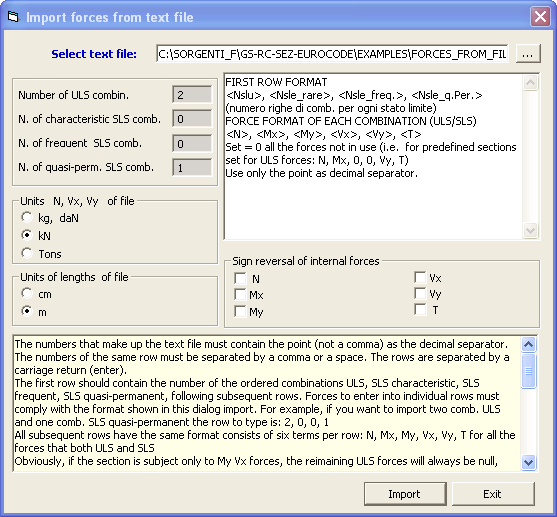If the section has a lot of load combination forces to check can be usefull to buid a text file containing such forces in a format defined in the following.
Once defined any section typology from the drop-down menu file should be selected the command Import forces from text file. After opening of below window you must select in the upper text box, the file name (already built and saved) to import. Select also the unit of force written in the text file. Reversal also eventual signs of forces for different sign conventions.

The numbers in the text file must contain the point (not a comma) as the decimal separator. The numbers of the same row must be separated by a comma or a space. The rows are separated by a carriage return (enter).
The first row should contain the number of the ordered combinations ULS, SLS characteristic, SLS frequent, SLS quasi-permanent, following subsequent rows. Forces to enter into individual rows must comply with the format shown in this dialog import. For example, if you want to import two comb. ULS and one comb. SLS quasi-permanent the row to type is: 2, 0, 0, 1
All subsequent rows have the same format consists of six terms per row: N, Mx, My, Vx, Vy, T for all the forces that both ULS and SLS
Obviously, if the section is subject only to My Vx forces, the remaining ULS forces will always be null, while in the SLS combinations SLS forces will be null My, Vx, Vy, T. So each row should always contain 6 numbers (although some of them are necessarily zero).
As the units of the imported forces may be different from those used by the program must be assigned (in the appropriate options) the units on forces to import. A similar assignment is made for signs of forces to import
In order to reverse (or keep) the correct sign of the forces in the file, please note that the program considers positive:
- Axial force N if compressive.
- The shear forces Vx, Vy if bound as the positive direction of the reference axes.
- Bending moment Mx if it compresses concrete fibers having max value of y-coordinate.
- Bending moment My if it compresses concrete fibers having max value of x-coordinate.
Below is an example of a text file that corresponds to a generic section with two comb. ULS and one comb. SLS quasi-permanent:
2,0,0,1
50.00, 60.00,25.00,80.00,10.00,0
0, 80.00, 45.00,20.00,15.00,0
70.00,46.00,15.30,0,0,0
This text file named "FORCES_FROM_FILE.txt" is saved for proof in the "Example" folder of the program.